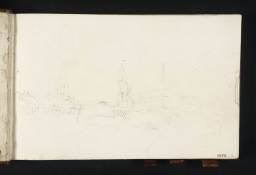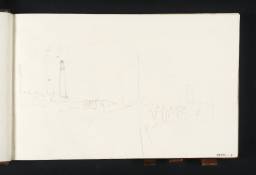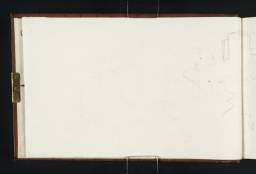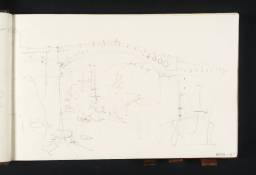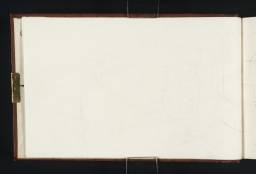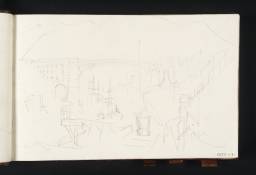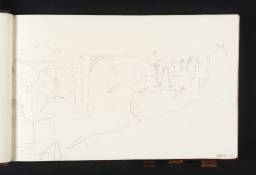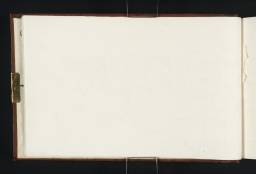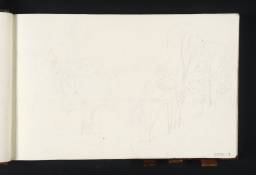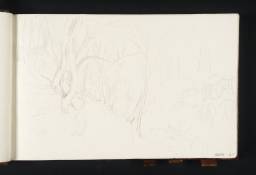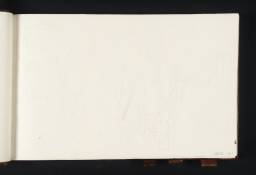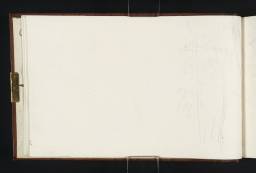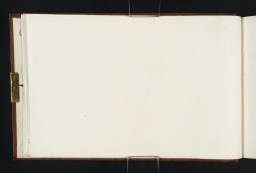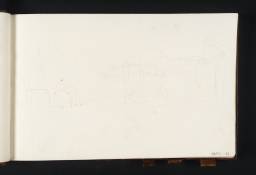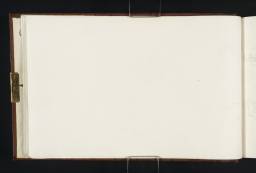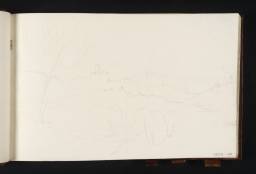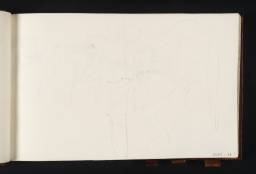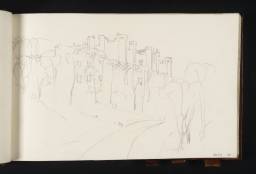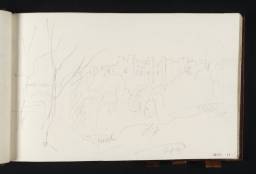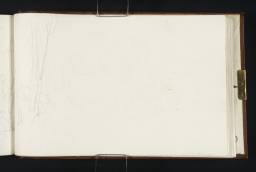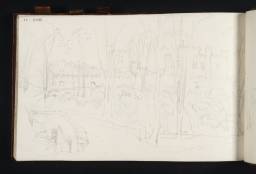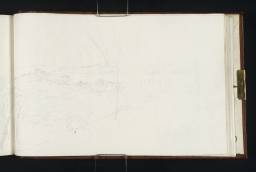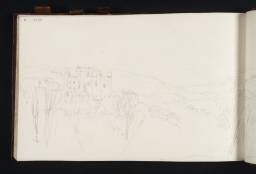Turner Bequest CLVII 1–93a
Sketchbook bound in boards, covered in brown leather with blind-stamped decorative scroll borders and brass mountings for a clasp (now missing); three leather pencil loops at bottom edge of back cover; seven double-ruled gilt bands on spine
93 leaves and pastedowns of white wove Whatman paper and endpapers; various sheets watermarked ‘J Whatman | 1814’; page size 116 x 185 mm (slightly irregular, narrowing towards outer edge)
Inscribed by Turner on label ‘32. Durham, North Shore’ (now lost, but presumably once glued to the spine) and in ink ‘Northumberland | and part of Durham’ on front cover (D40917)
Numbered 373 as part of the Turner Schedule in 1854 and endorsed by the Executors of the Turner Bequest inside front cover (D40918)
93 leaves and pastedowns of white wove Whatman paper and endpapers; various sheets watermarked ‘J Whatman | 1814’; page size 116 x 185 mm (slightly irregular, narrowing towards outer edge)
Inscribed by Turner on label ‘32. Durham, North Shore’ (now lost, but presumably once glued to the spine) and in ink ‘Northumberland | and part of Durham’ on front cover (D40917)
Numbered 373 as part of the Turner Schedule in 1854 and endorsed by the Executors of the Turner Bequest inside front cover (D40918)
Accepted by the nation as part of the Turner Bequest 1856
Exhibition history
References
This sketchbook was used by Turner on his tour of Durham and Northumberland in the autumn of 1817, along with the larger Raby sketchbook (Tate; Turner Bequest CLVI; see the introduction to the tour). There is no absolute internal evidence to assist in this dating, although some sketches are complementary to those of nearby sites in the other sketchbook and there are occasional duplications of subject matter, with views at Witton Castle in both, while the unidentified buildings on folio 92 recto (D12445) relate to a landscape in the Raby book. Gerald Wilkinson seems to have been expressing only an instinctive reaction in suggesting that the drawings here ‘now strike me as later and not connected with the Raby work, even though there are drawings of Bishop Auckland in both books.’1
To take the subjects in the present sketchbook in turn, there are views of the harbour and bridge at Sunderland on folios 1 recto–5 recto (D12318–D12324), and what seems to be a cliff on the coast nearby inside the back cover (D40923). As suggested in the introduction to the tour, it is possible that Turner had travelled there by sea up the East Coast. The accounts inside the front cover (D40918) suggest that he stayed at or visited Newcastle upon Tyne, a few miles north-west of Sunderland, before going on to Durham.
Sketches in and around Durham, about thirteen miles south-west of Sunderland or fourteen south of Newcastle, follow on folios 6 recto–14 recto (D12325–D12334), with a further view towards the end of the book on folio 76 verso (D12414). Working south-west from Durham, Brancepeth Castle appears next, on folios 15 recto and 16 recto (D12335, D12336) and also (perhaps indicating a return visit) on folios 74 verso and 75 verso (D12410, D12412). Further in the same direction, the next drawings are of Witton Castle and Witton-le-Wear on folios 16 verso–21 recto (D12337–D12344), and nearby Auckland Castle and its surroundings at Bishop Auckland on folios 21 verso–27 recto (D12345– D12354).
There are slight drawings of moorland scenery on folios 27 verso–52 recto (D12355–D12387), among them views of ‘Cock Lake’ folio 29 recto (D12358) and ‘towards Bowes’ on folio 52 recto (D12387). A view of Barnard Castle falls among them on folios 33 verso–34 recto (D12367, D12368), and the sequence appears in general to be of scenery west of Barnard Castle and Bowes, themselves not far south-west of Lord Darlington’s Raby Castle and Lord Strathmore’s neighbouring Streatlam Castle, recorded in detail in the Raby sketchbook. The overall sequence from folio 1 recto (D12318) to folio 52 recto (D12387) thus describes a more or less continuous south-western route of approaching forty miles from Sunderland through present-day County Durham to Barnard Castle, with a further excursion some miles onto the moors beyond.
Folios 53 recto–74 recto (D12388–D12409) are blank, and the drawings towards the end of the book are generally on the versos of the leaves, upside down in relation to the present foliation, suggesting that Turner worked inwards from the back cover. The identified subjects here are restricted to the Northumberland castles of Prudhoe and Bywell and their settings in the Tyne Valley, more than twenty miles west of Sunderland and some thirty miles due north of Barnard Castle. This links them with the second main phase of the tour, when Turner went ‘away to the north’2 with Lord Strathmore to make sketches at Gibside, a few miles south-east of Prudhoe, and Hylton Castle, just outside Sunderland, in the Raby sketchbook.
Working ‘backwards’ compared to the modern foliation, there are close-up sketches of Prudhoe Castle between folios 93 verso–89 verso (D12448–D12440), except for the unidentified subject mentioned above on folio 92 recto (D12445), followed by a sequence at Bywell, a few miles to the west, on folios 88 verso–81 verso (D12438–D12424), and a further sequence of Prudhoe Castle in its setting above the Tyne on folios 81 recto–77 verso (D12423–D12416).
Overall, this relatively small sketchbook seems to have been used for subjects which Turner found interesting in themselves rather than immediately requiring them for commissions. Various works in oil and watercolour produced very soon after the tour can be linked to specific, elaborate studies in the larger Raby sketchbook, but only one watercolour can definitely be linked to particular drawings in the present book: Prudhoe Castle, Northumberland (British Museum, London).3 This was engraved in 1828 for Turner’s Picturesque Views in England and Wales, having not been painted until about 1825, as described in the entries for folios 77 verso–78 recto (D12416, D12417). The England and Wales watercolour of Durham Cathedral (National Gallery of Scotland)4 was not produced until about 1836, and any link to the views on folios 8 recto and 9 recto (D12327, D12328) may be fortuitous, but it and two related colour studies are discussed in the entry for folio 6 recto (D12325).
Wilkinson 1977, p.145; no reservations as to this sketchbook’s dating are expressed in the same author’s The Sketches of Turner, R.A. 1802–20: Genius of the Romantic, London 1974, p.170.
Technical notes
How to cite
Matthew Imms, ‘Durham, North Shore sketchbook 1817’, sketchbook, February 2010, in David Blayney Brown (ed.), J.M.W. Turner: Sketchbooks, Drawings and Watercolours, Tate Research Publication, December 2012, https://www



